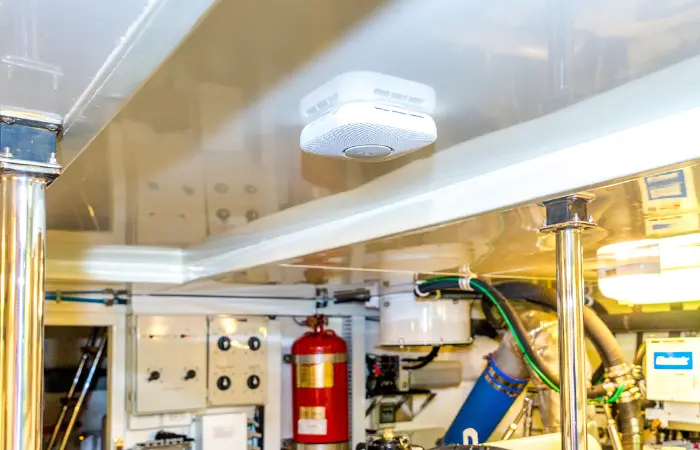
The saying “Out of sight, out of mind” rings true with many boat owners when talking about invisible and sometimes odorless gases. While conducting surveys with sail and power boats (gas and diesel), I am surprised to still find many vessels without carbon monoxide (CO), smoke or propane gas detectors. I’m also astonished to see vessels that are equipped with these devices, and they are either inoperable or disabled on purpose due to perceived or real false alarms.
Given the dangers involved with these deadly gases and the risks they pose to the owners, guests and crew, captains should ensure their boats comply with the standards of the American Boat and Yacht Council (ABYC) for their crew’s and guests’ safety.
Propane and carbon monoxide can potentially be deadly gases if not handled and monitored correctly. To do this, it’s important to understand what and how to deal with the risks.

LPG is used on boats for grills, stoves, heaters and ovens. If propane is not installed correctly and/or monitored and vented correctly, it can become a high safety risk. It’s also highly flammable, and if the gas leaks and accumulates in an enclosed space, it can explode when it comes into contact with an open flame or spark.
Propane systems can develop leaks that can be dangerous and difficult to detect. Leaking propane can build up inside the boat, creating a potentially explosive atmosphere. A slow leak can fill an accommodation space with lethal fumes and overwhelm the vessel’s occupants very quickly.
To mitigate these dangers, it’s crucial to install and maintain propane systems correctly. Here’s how:
• Install and use a propane detector according to the manufacturer’s instructions. Detectors should be installed at the lowest point possible near the appliance and where it is visible and will not be damaged.
• Regularly inspect and test the detector and ensure proper ventilation when using propane appliances.
• Inspect the propane locker and gasket, which should only open at the top and be above the waterline.
• Ensure the locker is vented at the bottom and vented overboard away from openings near accommodation spaces.
• A readily accessible electric or manual shutoff valve should be installed in addition to the propane tank valve.
• Fuel lines should be inspected and secured correctly.
• Each propane appliance should be supplied by a separate low pressure, regulated supply line originating from the propane locker.
If you see any signs of propane leaks or faulty equipment, shut off the propane and call a qualified technician immediately.
This colorless, odorless gas is produced when carbon- containing fuels like gasoline, diesel, natural gas and propane burn incompletely. On boats, CO can be a significant danger with internal combustion engines and generators. CO can come from your own boat or other vessels around you, so don’t be lured into a false sense of security because you have diesel power on your boat.

Poisoning risk is the biggest concern with CO. Inhaling it can lead to carbon monoxide poisoning, which can cause symptoms such as headache, dizziness, nausea, confusion, and in severe cases, death. CO poisoning can occur if exhaust gases are not properly vented, or if leaks or malfunctions are in your boat’s exhaust systems or other vessels are nearby and their fumes are venting into your vessel.
Since CO is odorless and colorless, detecting its presence can be a challenge without a carbon monoxide detector. With a moderate concentration of 1600 ppm (parts per million), headache, dizziness and nausea are present within five minutes and death occurs within 30 minutes.
To mitigate the dangers of carbon monoxide on a boat, it’s essential to have the proper equipment onboard and follow these guidelines:
• Install marine carbon monoxide detectors in all enclosed accommodation spaces, particularly near sleeping quarters but also galleys with a sink, head compartments and other enclosed spaces. Home CO detectors do not have the same specifications and operating parameters that are designed with the marine environment in mind.
• Maintain your CO detector and test regularly.
• Replace the CO detector every five years or at intervals based on the manufacturer’s recommendations.
• Regularly inspect and maintain propane and other exhaust systems to ensure they are functioning correctly and only use approved generators on your boat and according to the manufacturer’s instructions.
• Educate all occupants about the risks of carbon monoxide poisoning and the importance of proper ventilation.
The ABYC Standards A-1/A-14 (propane) and A-24 (carbon monoxide detection) provides guidance and requirements for proper installation and operation of detection devices. Additionally, using gas detectors for propane and carbon monoxide can provide early warnings and help prevent accidents and poisoning incidents. It is the captain’s responsibility to ensure a safe and enjoyable boating experience and avoid unnecessary risks.
Stay up to date with the latest articles, news and all things boating with a FREE subscription to Marinalife Magazine!
